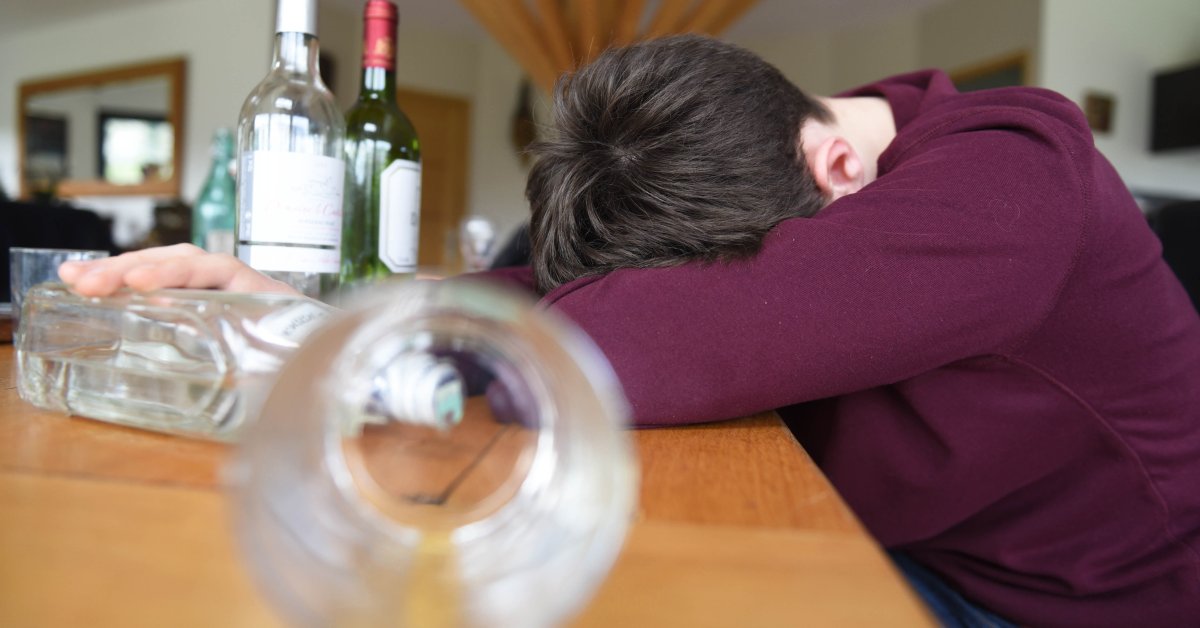ALCOHOL ADDICTION IN YOUTH
Drinking alcohol can affect how the brain develops in those under 25. Young people under 15 years are particularly at risk. Teenage brains are still developing, and the areas of the brain that undergo the most dramatic changes during the teenage years are the frontal lobe and hippocampus. These areas are associated with motivation, impulse control, and addiction.
Alcohol is a neurotoxin, which means it can damage the brain. One of the effects of excessive alcohol use is that it interferes with vitamin B absorption, which prevents the brain from working properly. Long-term drinking above the recommended levels may lead to a range of disorders, collectively known as alcohol-related brain injury (ARBI). Symptoms can include learning and memory problems, and difficulties with balance.
Teenagers can succumb to alcohol addiction just as adults do. The manner in that teens drink, though, differs significantly from their older counterparts. To understand teen alcohol addiction, you need to know why teens drink and what signs your teen may exhibit to indicate that they suffer from a problem.
When it comes to substance abuse, alcohol ranks at the top among teenagers. They use alcohol more often than marijuana or cigarettes. Also, their alcohol use tends to increase as they age. The percentage of teens who use alcohol among girls and boys does not have significant differences. Therefore, your teen girl is not exempt from underage drinking or alcohol addiction.
Teenagers do not have the same pattern of alcohol use as adults. Adolescents don’t drink as often, but much of what they consume happens through binge drinking episodes. Repeatedly binge drinking impacts the still-growing teenage brain. Teens who binge drink can experience long-term effects with cognitive impairment, attention, and memory.
The impacts on the brain can also make drinking in teens more likely to become an addiction. Teen drinking that starts before 15 can lead to a significantly greater likelihood of developing alcohol addiction in the future. However, external factors that lead teens to drink can also affect their chances of developing a dependency on alcohol and needing a substance abuse treatment program.
WHY DO SOME ADOLESCENTS DRINK?
Risk-Taking—Research shows the brain keeps developing well into the twenties, during which time it continues to establish important communication connections and further refines its function. Scientists believe that this lengthy developmental period may help explain some of the behavior which is characteristic of adolescence—such as their propensity to seek out new and potentially dangerous situations. For some teens, thrill-seeking might include experimenting with alcohol. Developmental changes also offer a possible physiological explanation for why teens act so impulsively, often not recognizing that their actions—such as drinking—have consequences.
Expectancies—How people view alcohol and its effects also influences their drinking behavior, including whether they begin to drink and how much. An adolescent who expects drinking to be a pleasurable experience is more likely to drink than one who does not.
Sensitivity and Tolerance to Alcohol—Differences between the adult brain and the brain of the maturing adolescent also may help to explain why many young drinkers can consume much larger amounts of alcohol than adults before experiencing the negative consequences of drinking, such as drowsiness, lack of coordination, and withdrawal/hangover effects. This unusual tolerance may help to explain the high rates of binge drinking among young adults.
Personality Characteristics and Psychiatric Comorbidity—Children who begin to drink at a very early age often share similar personality characteristics that may make them more likely to start drinking. Young people who are disruptive, hyperactive, and aggressive—often referred to as having conduct problems or being antisocial—as well as those who are depressed, withdrawn, or anxious, may be at the greatest risk for alcohol problems.
Hereditary Factors—Some of the behavioral and physiological factors that converge to increase or decrease a person’s risk for alcohol problems, including tolerance to alcohol’s effects, may be directly linked to genetics.
Environmental Aspects—Pinpointing a genetic contribution will not tell the whole story, however, as drinking behavior reflects a complex interplay between inherited and environmental factors, the implications of which are only beginning to be explored in adolescents. And what influences drinking at one age may not have the same impact at another.
WHAT ARE THE HEALTH RISKS?
Whatever it is that leads adolescents to begin drinking, once they start they face several potential health risks. Although the severe health problems associated with harmful alcohol use are not as common in adolescents as they are in adults, studies show that young people who drink heavily may put themselves at risk for a range of potential health problems.
Brain Effects—Scientists currently are examining just how alcohol affects the developing brain, but it’s a difficult task. Subtle changes in the brain may be difficult to detect but still have a significant impact on long-term thinking and memory skills. Add to this the fact that adolescent brains are still maturing, and the study of alcohol’s effects becomes even more complex. Research has shown that animals fed alcohol during this critical developmental stage continue to show long-lasting impairment from alcohol as they age. It’s simply not known how alcohol will affect the long-term memory and learning skills of people who began drinking heavily as adolescents.
Liver Effects—Elevated liver enzymes, indicating some degree of liver damage, have been found in some adolescents who drink alcohol. Young drinkers who are overweight or obese showed elevated liver enzymes even with only moderate levels of drinking.
Growth and Endocrine Effects—In both males and females, puberty is a period associated with marked hormonal changes, including increases in the sex hormones, estrogen, and testosterone. These hormones, in turn, increase the production of other hormones and growth factors, which are vital for normal organ development. Drinking alcohol during this period of rapid growth and development may upset the critical hormonal balance necessary for the normal development of organs, muscles, and bones. Studies in animals also show that consuming alcohol during puberty adversely affects the maturation of the reproductive system.
How can parents prevent teens’ alcohol use?
- Clear communication by parents about the negative effects of alcohol, as well as about their expectations regarding drug use, has been found to decrease teenage drinking significantly.
- Set clear expectations and boundaries around alcohol use, and enforce consequences if those boundaries are violated. Make it clear that underage drinking is not acceptable and that there will be consequences for any violations of this rule.
- Adequate parental supervision is a deterrent to alcohol use in youth. Alcohol, and other drug use, occur most often between the hours of 3 p.m. and 6 p.m., immediately after school and before parents arrived at home from work.
- Model responsible drinking behavior yourself. If you choose to drink, do so in moderation and avoid drinking to excess or in situations where it may be unsafe.
- Teen participation in extracurricular activities is therefore an important measure in the prevention of alcohol use in this age group.
- Parents can also help educate teens about appropriate coping and stress-management strategies. For example, 15- to 16-year-olds who use religion to cope with stress tend to use drugs significantly less often and have fewer problems as a result of drinking than their peers who do not use religion to cope.
- Monitor your teen’s activities and social connections, and be aware of any signs of alcohol use or other risky behaviors. Stay involved in their lives and know where they are and who they are with at all times.
- Since effective treatment of teen depression can be a deterrent to alcohol use, parents who seek help for their depressed teen promptly can also help prevent their adolescent from engaging in underage drinking.
- Educate yourself about the risks of underage drinking and the resources available to help prevent and address this behavior. Talk to your healthcare provider or seek out community resources for more information and support.
What are the symptoms of alcohol abuse in teens?
- Changes in behavior: Teens who abuse alcohol may experience changes in mood, behavior, and personality. They may become more irritable, aggressive, or anxious, or they may withdraw from friends and family.
- Academic problems: Alcohol abuse can interfere with school performance and lead to poor grades, absenteeism, and disciplinary problems.
- Changes in social activities: Teens who abuse alcohol may start to spend more time with peers who also drink, or they may start to withdraw from social activities altogether.
- Physical symptoms: Teens who abuse alcohol may experience physical symptoms such as headaches, nausea, and vomiting, as well as blackouts or memory lapses.
- Risky behavior: Teens who abuse alcohol are more likely to engage in risky behaviors, such as driving under the influence, having unprotected sex, lying, breaking curfew, becoming verbally or physically abusive toward others, having items in their possession that are connected to alcohol use (paraphernalia), or using other drugs.
- Legal problems: Alcohol abuse can lead to legal problems, such as arrests for underage drinking, stealing, or driving under the influence.
- Family problems: Alcohol abuse can also lead to family conflicts and problems, including arguments, fights, and other forms of domestic violence.
What is alcohol poisoning?
Alcohol poisoning is the potentially fatal result of drinking excessive amounts of alcohol in a short period. It is caused by alcohol slowing down the body’s functions (for example, breathing, heart rate, and gag reflex), thereby potentially leading to choking, coma, stopped breathing, stopped heart, and death. Treatment involves getting the person to the hospital immediately so medical professionals can watch the person closely, give the person oxygen and fluids, and take other measures to prevent choking, as well as stop breathing or heartbeat.
Assessment and Treatment
Therapeutic communities (TCs) – are a social-psychological form of treatment for addictions and related problems with a focus on resocializing those who attend.
Cognitive behavioral therapy (CBT) – refers to those approaches that focus primarily on an individual’s thoughts and behaviors. CBT has been used to treat many psychological problems, including depression, anxiety, stress, and anger.
Family therapy – takes many forms. Family therapies such as Multidimensional Family Therapy (MDFT) view adolescent alcohol and drug use as influenced by the community, the family, and peers. Treatment includes individual and family sessions, which can be held at home, at school, in the clinic, or other areas of the community.
Detoxification – settings are often included as part of a 28-day intensive inpatient treatment. Detoxification generally refers to a 3- to 5-day period of intensive medical monitoring and management of withdrawal symptoms.




